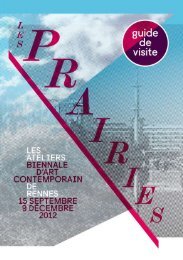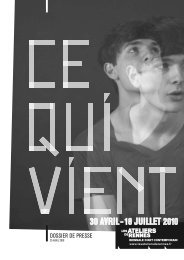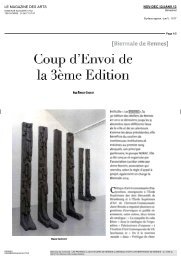Download here the Visitor's guide. - Les Ateliers de Rennes
Download here the Visitor's guide. - Les Ateliers de Rennes
Download here the Visitor's guide. - Les Ateliers de Rennes
You also want an ePaper? Increase the reach of your titles
YUMPU automatically turns print PDFs into web optimized ePapers that Google loves.
MATHIEU K. ABONNENC<br />
PIERRE LEGUILLON<br />
YANN SéRANDOUR<br />
Sans Tambours ni trompettes, 2012. Photography : Yann Sérandour.<br />
<strong>Les</strong> Prairies's artists<br />
Co-Production<br />
<strong>Les</strong> <strong>Ateliers</strong> <strong>de</strong> <strong>Rennes</strong> 2012,<br />
Cabinet du livre d'artiste.<br />
Avec le soutien <strong>de</strong><br />
l'entreprise Self Signal.<br />
Just to prove that, in <strong>the</strong> words of Mallarmé, "everything in <strong>the</strong> world exists in or<strong>de</strong>r to end up as<br />
a book", Yann Sérandour's part in this concerns <strong>the</strong> first stage in <strong>the</strong> existence of books: making<br />
<strong>the</strong> paper. In his installation at <strong>the</strong> Newway Mabilais he conjures up both <strong>the</strong> experiments of <strong>the</strong><br />
brilliant scientist-printer David Séchard in Balzac's Lost Illusions and <strong>the</strong> ancestral Japanese<br />
marbling technique of suminagashi. A teaching aid – a textbook on <strong>the</strong> history of papermaking<br />
published in 1954 in Japan – is used as a matrix. Its marbled flyleaf is blown up to <strong>the</strong> exact<br />
dimensions of <strong>the</strong> Cabinet du Livre d’Artiste (CLA). The eight windows of <strong>the</strong> venue are each<br />
covered by <strong>the</strong> corresponding part of <strong>the</strong> image. From that moment on, <strong>the</strong> CLA becomes a<br />
pre<strong>de</strong>termined area comparable to a page of a book and <strong>the</strong> artists' intervention is <strong>the</strong> response<br />
to a problem of page layout, converted to <strong>the</strong> three dimensions of <strong>the</strong> venue's architecture.<br />
First on <strong>the</strong> blank paper are images, old photo prints from press agencies. These are supplied<br />
by Pierre Leguillon who collected <strong>the</strong>m over <strong>the</strong> years. They are pictures of American mobile<br />
libraries from <strong>the</strong> 1950s. Then comes <strong>the</strong> text: notes, dates and captions inscribed by Mathieu<br />
K. Abonnenc directly onto <strong>the</strong> Perspex of <strong>the</strong> windows, following <strong>the</strong> curves of <strong>the</strong> marbling on<br />
<strong>the</strong> paper and creating a historical frieze whose rigour is thwarted by <strong>the</strong> random nature of <strong>the</strong><br />
papermaking technique. By working in layers, each one of which corresponds to one of <strong>the</strong> artists,<br />
to one medium and one level of interpretation, Yann Sérandour, Pierre Leguillon and Mathieu K.<br />
Abonnenc create a historical fabric in <strong>the</strong> microcosm of <strong>the</strong> space of a window.<br />
A. N. tr. J.H.<br />
retrouvez ces artistes au Cabinet du livre d’artiste<br />
69






